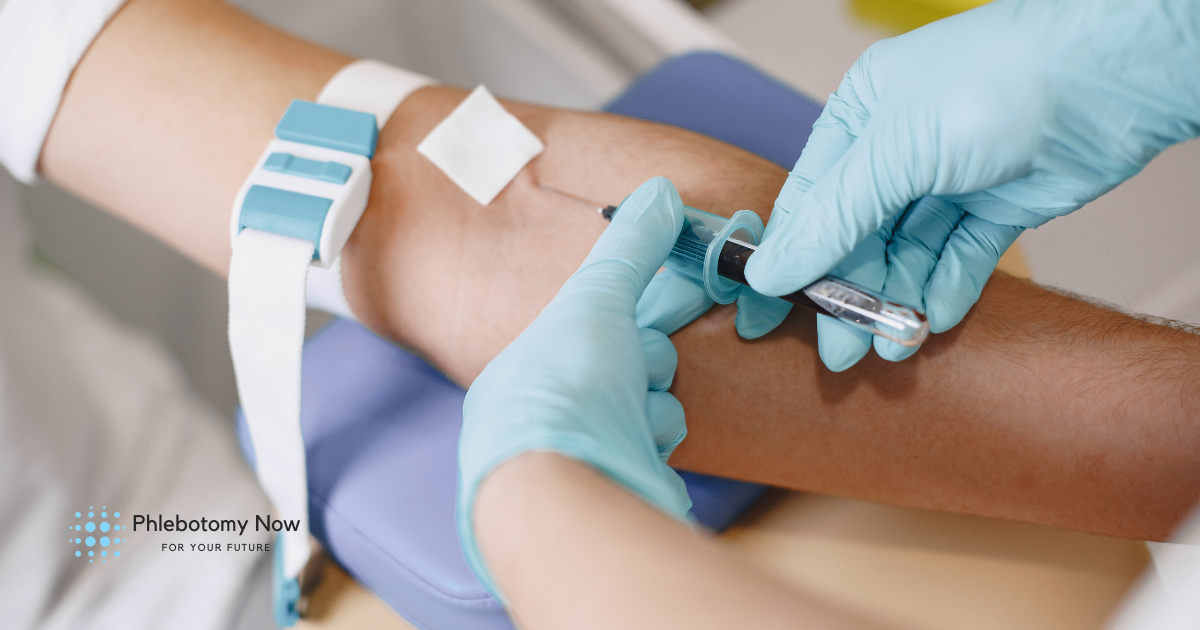Healthcare runs on a complex web of interconnected roles. The unassuming phlebotomy technician plays a vital yet often unseen part. But what exactly does a phlebotomy technician do? Dive into a day in their life. Discover the many responsibilities that contribute to patient care. They lead to accurate diagnoses and better health.
A Day in the Life of a Healthcare Hero
| Key takeaways | ||||||||||||||
| Phlebotomy technicians play a vital role in healthcare by drawing blood for tests and procedures. | ||||||||||||||
|
A Day in the Life
|
||||||||||||||
|
Specializations and Career Growth:
|
||||||||||||||
|
The Impact: Phlebotomy technicians are unseen heroes who contribute significantly to accurate diagnoses, timely treatments, and patient well-being. |
||||||||||||||
|
Considering a Phlebotomy Career?
|
The Morning Routine:
Setting the Stage for Efficiency
The day starts with preparation. The phlebotomy technician sanitizes their workspace. They do this to ensure a sterile environment for blood collection. They prepare vials, syringes, and other equipment. They make sure each item is available and labeled. Reviewing schedules and patient information is crucial. It lets them expect specific needs and streamline collections.
The Patient Encounter:
Building Trust and Comfort
From the first interaction, the phlebotomy technician acts as a patient advocate. They greet patients . They explain the procedure clearly. They address any anxieties or concerns with empathy and professionalism. Effective communication is key. They listen attentively and answer questions patiently. They provide clear instructions to ensure a smooth and comfortable experience.
The Art of Blood Collection:
Precision and Care
The core responsibility lies in drawing blood accurately and efficiently. This involves finding suitable veins. It also involves using techniques like tourniquets and needle placement. The goal is to ensure the patient feels as little pain as possible. Paying close attention to detail is key. The technician carefully collects the needed blood volume. They do this while keeping things sterile and following safety protocols.
Beyond the Blood Draw:
Supporting Patient Well-being
The phlebotomy technician’s role goes beyond the physical act of blood collection. They observe and document vital signs. These include blood pressure, temperature, and respiration. This helps to create a holistic view of the patient’s health. They may also offer emotional support. They genuinely care and address any anxieties or concerns.
The Lab Connection:
Ensuring Sample Integrity
Once the technician draws the blood, they label and process the samples. They ensure accurate identification and adherence to specific test needs. They may spin samples to separate parts. They prepare smears for microscopes or do other tasks. These tasks get the samples ready for technicians to analyze.
Administrative Duties:
Keeping the System Running Smoothly
Documentation plays a critical role in healthcare. The technician records all procedures. They also record patient info and test details in electronic medical records. They do this to ensure accurate data for diagnosis and treatment planning. They may also manage inventory and order supplies. They maintain equipment functionality, ensuring smooth operation of the phlebotomy department.
Continuing Education:
Staying Sharp in a Dynamic Field
Medicine is always changing. Phlebotomy technicians keep up through education. They attend workshops, conferences, and online courses. They do this to update their knowledge. They learn about new blood collection techniques, test needs, and safety rules. They commit to continuous learning. This ensures they provide the most accurate and efficient care.
Beyond the Routine:
Specializations and Career Growth
The core responsibilities stay the same. But, phlebotomy technicians can specialize. They can focus on areas such as pediatric blood draw, blood donation, or research. This allows them to tailor their skills and knowledge. They can tailor them to specific patient groups or clinical settings. With experience and more training, they can pursue further career opportunities. They can become medical laboratory technicians, phlebotomy instructors, or even registered nurses.
The World of Phlebotomy: From Titles to Tasks
The world of healthcare relies on a team of dedicated professionals, and phlebotomists play a vital role in this network. They are the skilled individuals who collect blood samples, ensuring doctors have the information they need to diagnose and treat patients.
Wearing Many Hats: Phlebotomy Job Titles
While “phlebotomist” is the most common title, you might encounter variations depending on the workplace. Here are a few examples:
- Phlebotomist Technician
- Blood Collector
- Blood Drawer
- Patient Care Technician (PCT) (may include phlebotomy duties)
Beyond the Needle: Tasks and Duties
A phlebotomist’s day involves more than just drawing blood. Here’s a glimpse into their responsibilities:
- Drawing Blood (Venipuncture): Using sterile techniques, phlebotomists locate veins, insert needles, and collect blood samples in tubes.
- Collecting Samples: They may also collect other body fluids like urine or perform finger pricks for blood glucose tests.
- Labeling Samples: Accurate labeling ensures the right sample reaches the lab for the correct test.
- Patient Interaction: Phlebotomists put patients at ease, answer questions, and ensure a smooth collection process.
- Maintaining Equipment: They keep supplies sterilized and equipment functioning properly.
- Adhering to Safety Protocols: Infection control and patient safety are paramount for phlebotomists.
Sharpening the Skills: Education and Certification
Working as a phlebotomy technician requires specific training and certification. Here’s what you’ll typically need:
- Phlebotomy Technician Program: A certificate program from an accredited institution equips you with the necessary skills and knowledge.
- Certification: Passing a national certification exam demonstrates your competency to employers.
- Continuing Education: Keeping skills sharp through ongoing education ensures you stay updated on best practices.
Where the Work Gets Done: Places of Employment
Phlebotomists can find rewarding careers in various healthcare settings:
- Hospitals: They play a crucial role in patient care within hospital wards and emergency departments.
- Clinics: Doctors’ offices, walk-in clinics, and specialized clinics often require phlebotomy services.
- Blood Donation Centers: Ensuring a steady supply of blood for transfusions and treatments is another vital area for phlebotomists.
- Home Health Care: In some cases, phlebotomists may collect blood samples from patients in their homes.
The Tools of the Trade: Procedures and Tests
Phlebotomists are involved in various procedures related to blood collection, some of which include:
- Blood Draw (Venipuncture): This is the most common procedure, where blood is drawn from a vein in the arm.
- Capillary Puncture: For infants or situations where venous access is difficult, a finger prick might be used.
- Blood Tests: Phlebotomists collect samples for a wide range of blood tests, ordered by doctors to diagnose and monitor health conditions.
So, if you’re interested in a healthcare career that’s both hands-on and plays a significant role in patient care, then phlebotomy might be the perfect fit for you.
The Impact of a Phlebotomy Technician:
More Than Just a Blood Draw

Phlebotomy Now – What does a Phlebotomy technician do
The work of a phlebotomy technician may seem simple on the surface. Yet, it carries immense significance. They dedicate themselves. They ensure accurate diagnoses. They help with timely treatments. They help the well-being of patients. They are the unseen heroes. They play an important part in the intricate network of healthcare..
FAQs:
What does a phlebotomy technician do?
Phlebotomy technicians draw blood from patients for various tests and procedures. They also do other tasks. These include labeling samples, caring for equipment, and ensuring patient comfort.
What skills does someone need to become a phlebotomy technician?
Phlebotomy technicians need strong communication, interpersonal, and technical skills. They should be detail-oriented, compassionate, and able to work well under pressure.
What is the job outlook for phlebotomy technicians?
The Bureau of Labor Statistics predicts this. It says that phlebotomy technicians’ job outlook will be above average. This makes it a promising career.
How can I become a phlebotomy technician?
You can complete a phlebotomy technician certification program. It takes several months to a year. Phlebotomy Now offers accredited programs to help you get started.
Remember, the demand for skilled phlebotomy technicians is growing . With Phlebotomy Now, you can gain the skills and confidence. You need them to start a successful career in this rewarding field. Let’s start building a healthier future together.
Take the first step towards becoming a phlebotomy technician today!
Contact Phlebotomy Now to learn more about our programs. Start your journey to making a real difference in patient care.







